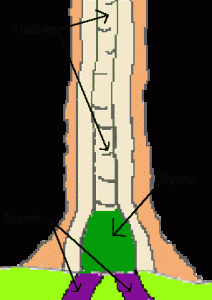Bird Vocalizations
Birds and mammals have very different vocalization organs. Mammals like us have a larynx (voice box) which is located at the top of the trachea and which manipulates pitch and volume. It houses the vocal folds (also called vocal folds), which are hard membranes which stretch across the larynx. When air flows across the vocal cords they vibrate during speech or singing (somewhat like the strings on a violin), sometimes oscillating as fast as 440 times per second when holding A above middle C.

Figure 6.53: The vibration of the walls of the syrinx allow a bird to produce sounds.
Image from URL: http://www.earthlife.net/birds/song.html
By contrast, the syrinx – the vocal organ of a bird – is a unique bony structure surrounded by an air sac which lies at the lower end of the trachea. Unlike the larynx, a bird’s syrinx contains no vocal chords. Instead, sound is produced in this organ through the vibration of the walls of the organ. Within its surrounding air sac it acts as a resonating chamber. In essence, the way sound is made by the larynx versus the syrinx is analogous to sounds produced by a violin and a kettle drum. The sound a bird makes with its syrinx is altered both by muscles that change the tension within the organ (thus changing the pitch) and by moving air over the syrinx at a great speed in order to change the volume.
A bird’s syrinx is really a double instrument because part of it connects to each of the two bronchi and each half is capable of making unique sounds. This means that a bird can sing two different notes at the same time, or even sing a duet with itself. Thrushes can sing rising notes with one half of the syrinx and falling notes with the other half – at the same time! Other birds use their dual vocal chords in different ways such as using one side for low notes and the other for high ones. Cardinals can switch from one side to the other in mid-note while canaries breathe through one side and sing with the other. Cowbirds sing very rapid notes one alternately from each side. It is this sort of ability that allows some birds to sing as many as 30 separate notes per second.
If birds lack a larynx, the voice box associated with human speech, how do parrots, budgies, and other birds imitate human speech? There are actually several different techniques used by birds, often depending on their size. Unlike most birds, parrots have thick tongues – more like human tongues than bird tongues – which allow them to form the sounds of words somewhat like we do. They emit a preliminary sound from their syrinx and then modify it using the mouth, throat and tongue. The much smaller budgies do not have a thick muscular tongue. Instead, they use their syrinx to create a 2-3 Kilohertz carrier frequency, then add a second vibration to it. This is a well-known scientific system called frequency modulation and is the principle behind FM radio.
One of the best mimics is the beautiful lyrebird, as demonstrated in the following video:
Click here to view the video directly on YouTube.
For more on the science behind bird vocalizations, take a look at the article Song learning in birds: diversity and plasticity, opportunities and challenges (pdf) from the University of Washington website.
You may also want to take a look at the following gadgets (we will be using one in the field) that can help to identify bird sounds:
BirdSong IdentiFlyer Ultimate Kit
Bird Vocalizations & Sounds of Another Feather
Not all birds sing and not all the sounds birds make are called songs. Singing is limited to the order Passeriformes, or perching birds. This means that nearly half of the birds in the world do not sing. They are not, however, silent. Nearly all birds use sounds to communicate. Most birds use vocalizations, which are short and unmusical and cannot be termed as songs. These sounds have considerable functionality and are generally labeled call-notes or calls to distinguish them from true songs.
Call notes can be divided into at least 10 different categories:
1) General alarm calls
2) Specialized alarm calls
3) Distress calls
4) Aggressive calls
5) Territorial defense calls
6) Flight calls
7) Nest calls
8) Flock calls
9) Feeding calls
10) Pleasure calls
Not all of the sounds a bird makes are generated by the syrinx. Some of the most amazing sounds associated with mating are actually made by rapid snapping of the wings against the flanks, by wind “winnowing” through tail feathers, or the popping of special air sacs.
The mating ritual of the red-capped manikin is an amazing example of the use of body language to attract a mate, demonstrated in the following video. Move over Michael Jackson!
Click here to view the video directly on YouTube.
For more on bird vocalizations, refer to the following websites:
- Bird Voices from Stanford University.
- Bird Sounds from Earthlife.net.
- Vocal Communication from Eastern Kentucky University (Note: This page contains lots of embedded YouTube videos which may not play if YouTube is blocked from your computer).
As we move towards learning to identify birds, it can be very helpful to check out various websites that provide insights into the appearance, habitat, and vocalizations of some commonly seen birds. For one example, REVIEW the enature.com field guide entry for the red-winged blackbird, which includes playable sound.
A list of enature.com websites of 50 mostly common birds is available at this link. Some of the birds here are not found in our area. These would include the yellow-billed cuckoo, the northern cardinal, the red-shouldered hawk and the inigo bunting. Three of these birds are actually eastern rather than western varieties (eastern wood peewee, eastern screech owl and eastern meadowlark). But it is still worthwhile for the new birder to take a look.